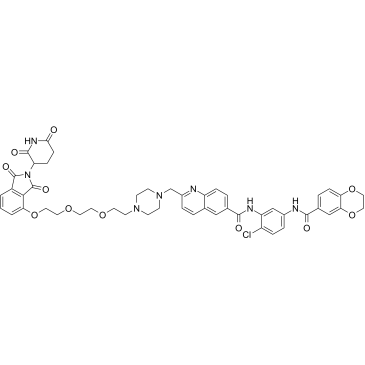| Cas No.: | 2229856-58-8 |
| Chemical Name: | N-(2-Chloro-5-(2,3-dihydrobenzo[b][1,4]dioxine-6-carboxamido)phenyl)-2-((4-(2-(2-(2-((2-(2,6-dioxopiperidin-3-yl)-1,3-dioxoisoindolin-4-yl)oxy)ethoxy)ethoxy)ethyl)piperazin-1-yl)methyl)quinoline-6-carboxamide |
| Synonyms: | CCT367766;CCT 367766 |
| SMILES: | N1C2C(=CC(C(NC3=CC(NC(C4=CC=C5C(=C4)OCCO5)=O)=CC=C3Cl)=O)=CC=2)C=CC=1CN1CCN(CCOCCOCCOC2=CC=CC3=C2C(=O)N(C2CCC(=O)NC2=O)C3=O)CC1 |
| Formula: | C49H48ClN7O11 |
| M.Wt: | 946.41 |
| Purity: | >98% |
| Sotrage: | 2 years -20°C Powder, 2 weeks 4°C in DMSO, 6 months -80°C in DMSO |
| Publication: | [1]. Chessum NEA, et al. Demonstrating In-Cell Target Engagement Using a Pirin Protein Degradation Probe (CCT367766).J Med Chem. 2018 Feb 8;61(3):918-933. |
| Description: | CCT-367766 (CCT367766) is a novel heterobifunctional PROTAC that binds and degrades the putative transcription factor regulator Pirin in cells. |
| Target: | CRBN-DDB1:490 nM (IC50) |
| In Vitro: | CCT367766 (50-1500 nM; 24 hours) demonstates the depletion of pirin protein as a the time-dependent hook-effect in SK-OV-3 human ovarian cancer cells[1]. CCT367766 (0.5-50 nM; 2 hours) demonstrates the concentration-dependent depletion of pirin protein after 2 h exposure in SK-OV-3 cells[1]. Western Blot Analysis[1] Cell Line: SK-OV-3 human ovarian cancer cells Concentration: 50, 150, 250, 500 and 1500 nM Incubation Time: 2 hours, 4 hours, 24 hours Result: Decreased pirin protein expression. Western Blot Analysis[1] Cell Line: SK-OV-3 human ovarian cancer cells Concentration: 0.5, 1, 2.5, 5, 7.5, 10, 25, and 50 nM Incubation Time: 2 hours Result: Completely degraded pirin just at 50 nM treatment. |
| References: | [1]. Chessum NEA, et al. Demonstrating In-Cell Target Engagement Using a Pirin Protein Degradation Probe (CCT367766).J Med Chem. 2018 Feb 8;61(3):918-933. |

 DC Chemicals' products qualify for U.S. tariff exemptions. We guarantee no price increases due to customs duties and maintain stable supply, continuing to deliver reliable research solutions to our American clients.
DC Chemicals' products qualify for U.S. tariff exemptions. We guarantee no price increases due to customs duties and maintain stable supply, continuing to deliver reliable research solutions to our American clients.





















